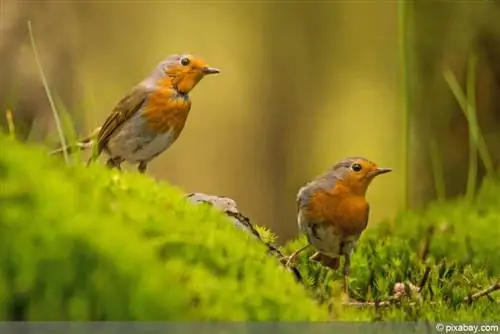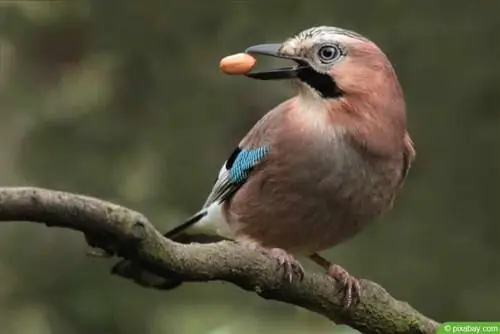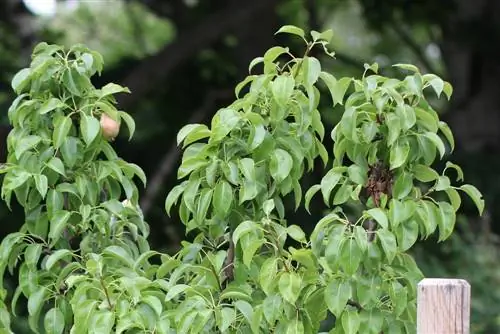- Author admin [email protected].
- Public 2023-12-17 03:39.
- Last modified 2025-01-24 12:45.
Robins are aptly named native birds that help gardeners eliminate pests and entertain them with their varied songs. They can serve well in the garden and should therefore be cared for and welcomed as much as possible as natural predators of insects. The robins are of great value, especially if chemical agents are to be avoided. But how can the animals be attracted and perhaps even encouraged to breed in your own garden?
Robin profile
- Scientific name: Erithacus rubecula
- Appearance: Brown and gray plumage with reddish-orange breast, throat and forehead
- Body shape: rounded and slightly stocky
- Size: 13 to 14 centimeters
- Weight: about 15 to 18 grams
- Wingspan: approx. 22 centimeters
- Breeding season: From March to April, two to three times a year
- Nesting sites: closer to the ground in the thicket
- Laying scope: up to six eggs
- Food: insects and soft seeds
- Singing: distinctive communication with members of the same species, which is expressed through ticks, ticks and chattering noises, is usually heard at dusk and strongly in fog
- Life expectancy: up to 5 years
- Migration behavior: In the north and east of Europe the migration begins around October
- Wintering: partly in North Africa and the Mediterranean
- Enemies: humans, cats, martens, birds of prey
Dissemination
The robin belongs to the order of passerines, to the suborder of songbirds and here to the family of flycatchers. It lives in North Africa, Europe and Asia Minor. It can also be found in the Mediterranean region, but not in Scandinavia and other northern areas.
As a habitat, it prefers areas close to water and areas with numerous trees, such as those found in parks, forests and also gardens.
If you want to spot robins in your own garden, you should provide appropriate conditions. These include:
- varied trees
- Water, such as a garden pond or watercourse, alternatively a bird bath
- Hiding options through bushes and hedges
- Plants that produce soft seeds, such as privet, whitebeams, berries, daphne or the aptly named robin's bread
- Nest boxes in a protected location
Train behavior
In the north and east of Europe, robins migrate south in autumn and overwinter in the warmer Mediterranean region and North Africa. In Germany they are occasional guests at the feeding house even in winter. Attentive listeners can easily determine whether the red-throated birds still visit their own garden in winter or whether they are still present in the living area.
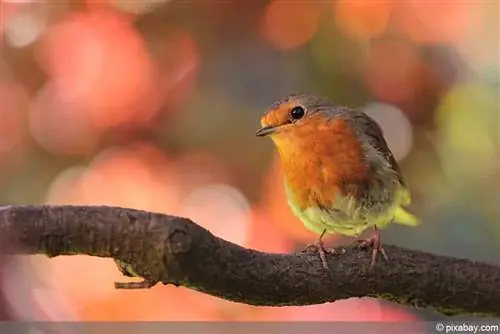
Robins also make the typical “zig”, “zip” and “zig” sounds in autumn and winter. Exceptions here are heavy rains. In such weather, the Erithacus rubecula become completely silent.
Food
This is where things become interesting for gardeners in many ways and the robin is useful, because the birds feed almost exclusively on insects during the breeding season and in the warm months. This is of great use in the garden, as the Erithacus rubecula pecks off the ground as well as tree bark and plants. They have even been observed catching aquatic insects.
So you can help gardeners keep pests at bay. However, they should still be fed even if the insects are not in abundance - otherwise they will look for a new area of activity. It is therefore crucial that plant-based food is also made available to them and that they are adequately cared for in winter.
Eating behavior
Robins, as mentioned, feed on berries and seeds, but prefer insects. They also prefer food rich in protein and fat, especially in winter. Instead of grains, they should be offered insects and fatty food, ideally close to the ground or with a large approach area. Good feeding options are:
- on the ground, for example on a board and protected by wire mesh; The food can also be sprinkled directly onto the snow
- on the windowsill
- in a birdhouse or feeder with a large base plate
- as a food ball with a board underneath it
Robins want to be able to land and rarely fly to hanging food sources. It therefore always makes sense to provide them with a base plate. Of course, this should be protected from attacks by other animals.
Courtship season
The courtship period and the laying of eggs occur several times a year. A female enters the territory of a male and shows infantile behavior. It appeases and begs for food. This is also necessary because the male's courtship behavior is impressive and aggressive.
If the male robin allows himself to be appeased, he feeds the female and then mate with her. The sexual act is brief and can occur before, after or even without feeding by the male. It is repeated several times a day, from the first mating to the construction of the nest to the laying of the last egg, with courtship behavior preceding each case. The birds are also very fond of singing during this time.
breeding season
Robins breed several times a year. The first clutch occurs between March and April. The second clutch follows around June or July. A third brood is possible, but extremely rare. If you have robin nests in your garden, you should refrain from trimming hedges and trees during the breeding season.
The parents and young animals would be frightened and stressed and would then look for a new home. If you want to keep the useful robins in the garden, proceed carefully and avoid using loud devices.
Nesting sites
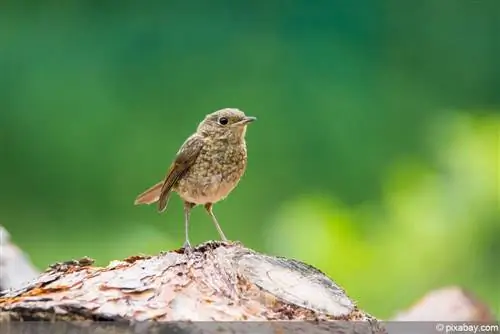
Robins prefer to nest in thickets close to the ground, for example in blackberry bushes or hedges. Here they build shallow nests that only take a few days to construct. However, they can also be offered alternatives. And this is even necessary when cats, martens and larger birds of prey are very active in the area. Nesting boxes on the wall of the house, a tree or in the hedge are ideal. To make it more attractive to robins, it should be somewhat hidden, i.e. surrounded by plants. It is also important that they cannot be reached by other animals and only have a small entrance opening.
Tip:
Placed within sight of a window and close to the feeding place, you can relax and observe the hustle and bustle of the young birds, including their first attempts to fly. You can also intervene if a nestling falls. It is a myth that birds no longer accept their young after contact with humans.
Protection from enemies
Cats and martens are among the robin's typical enemies, but birds of prey can also be dangerous to them. They should therefore be comprehensively protected in the garden. The following are useful:
- Hedges and bushes, berries, privet and densely leafy trees
- Protective rings made of wire on tree trunks to prevent cats and martens from climbing
- a feeding area protected with wire mesh bent on the outside
- Collection trays under the feeding places
- Climbing protection under the nesting sites
- choose inaccessible places for nesting and feeding, for example a window sill on the first floor
Dense planting is essential for attracting robins. Piles of leaves or “wild” areas in the garden are also suitable for this. Natural meadows, brushwood and partial mowing of the lawn are good measures. The latter simply means not mowing all the meadows and lawns on the same day. On the one hand, this means that the robins are less disturbed. On the other hand, they are offered a buffet, so to speak.
Conclusion
Robins are beneficial insects in the garden and - although they are not threatened - should be welcomed. With the right knowledge about feeding, breeding and enemies, this is very easy and rewarding. Because the singing and activity of the Erithacus rubecula alone is a relaxing spectacle.

